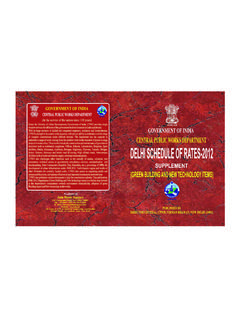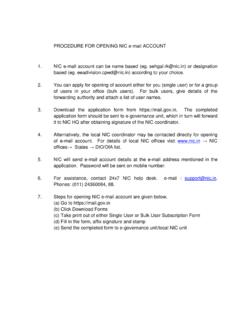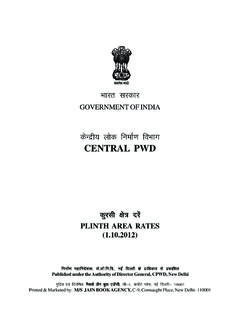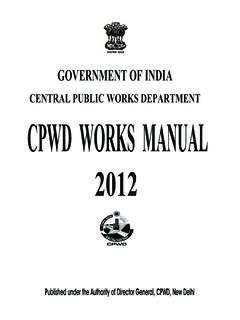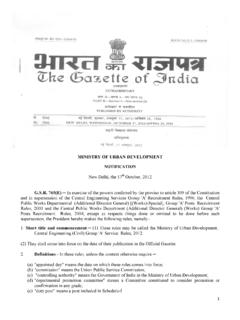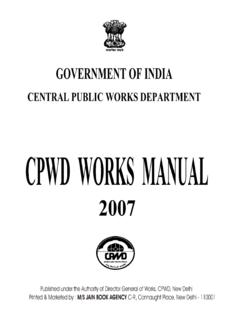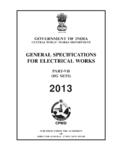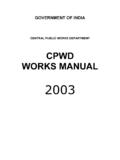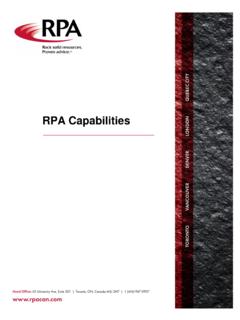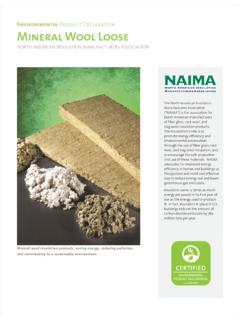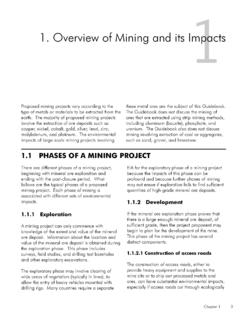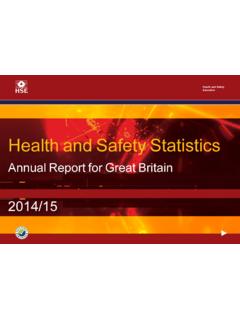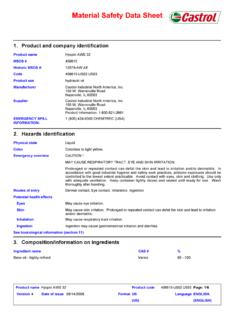Transcription of Ch. 20-21 - CPWD
1 Handbook of Landscape Chapter-1. Definitions (Source : NBC). 1. Avenue : A wide road or pathway lined with trees on either side. 2. Buffer : The use of landscape to curtail view, sound or dust with plants or earth berms, wall, or any such element. 3. Climber (Creeper/Vine) : A non-supporting plant, woody or herbaceous, which clings to a wall, trellis or other structures as it grows upward. 4. Columnar : A slender, upright plant form. 5. Egress : A way out, or exit. 6. Elevation : A contour line or notation of relative altitude, useful in plotting existing or proposed feature. 7. Exotic : A plant that is not native to the area in which it is planted. 8. Fencing : A barrier of plant or construction material used to set off the boundary of an area and to restrict visual or physical passage in or out of it.
2 9. Foliage : The collective leaves of a plant or plants. 10. Geo-textile : Any permeable textile (natural or synthetic) used with foundation, soil, rock, earth or any other geotechnical engineering-related material as an integral part of a human made project, structure or system. 11. Grade : The slope or lay of the land as indicated by a related series of elevations. 11a Natural Grade : Grade consisting of contours of unmodified natural land form. 11b Finished Grade : Grade accomplished after landscape features are installed and completed as shown on plan as proposed contours. 12. Gradient : The degree of slope of a pipe invert or road or land surface. The gradient is a measure of the slope height as related to its base. The slope is expressed in terms of percentage or ratio.
3 13. Grading : The cutting and/or filling of earth to establish smooth finish contours for a landscape construction project. Grading facilitates good drainage and sculpts land to suit the intent of landscape design 14. Grasses : Plants that characteristically have joint stems, sheaths and narrow blades (leaves). 15. Groundcover : The planting material that forms a carpet of low height; these low-growing plants are usually installed as the final part of landscape construction. 16. Hard Landscape : Civil work component of landscape architecture such as pavement, walkways, roads, retaining walls, sculpture, street amenities, fountains and other built environment. Central Public Works Department 1. Handbook of Landscape 17. Hardy Plant : Plants that can withstand harsh temperature variations, pollution, dust , extreme soil conditions, and minimal water requirements and the likes.
4 These plants have ability to remain dormant in such conditions and survive. 18. Hedge : Number of shrubs or trees (often similar species) planted closely together in a line. A hedge may be pruned to shape or allowed to grow to assume its natural shape. 19. Herb : An annual plant with a non-woody or fleshy structure. Certain herbs are highly useful for cooking or of high medicinal value. 20. Ingress : A way in, or entrance. 21. Invert : The low inside point of a pipe, culvert, or channel. 22. Kerb : A concrete or stone edging along a pathway or road often constructed with a channel to guide the flow of storm water and thereby serving dual purpose. 23. Mound : A small hill or bank of earth, developed as a characteristic feature in landscape.
5 24. Native : A plant indigenous to a particular locale. 25. Planting : Planting is the operation of transferring young plant from nursery to their permanent place in landscape. 26. Screen : A vegetative or constructed hedge or fence used to block wind, undesirable views, noise, glare and the like, as part of in landscape design; also known as screen planting' and buffer plantation'. 27. Sediment : The product of erosion processes; the solid material, both mineral and organic, that is in suspension, is being transported or has been moved from its site of origin by air, water, gravity or ice. 28. Shrub : A woody plant of low to medium height, deciduous or evergreen, generally having many stem. 29. Soft Landscaping : The natural elements in landscape design, such as plant materials and the soil itself.
6 30. Spot Elevation : In surveying and contour layout, an existing or proposed elevation noted as a dot on the plan. 31. Street/Outdoor Furniture : Items of furnishing in outdoor landscape. 32. Swale : A linear wide and shallow depression used to temporarily store, route or filter runoff. A swale may be grassed or lined. 33. Topsoil : The uppermost layer of the soil. 34. Transplanting : Moving a plant from its place of origin to another location. Transplanting is the process of bodily lifting of mature and large plants from their position to a new position. 35. Tree : A woody plant, generally taller than m, with a well-distinguished trunk or trunks below the leaf crown. 35a. Deciduous Tree : Tree that sheds all its leaves in autumn or in dry season.
7 2 Central Public Works Department Handbook of Landscape 35b. Evergreen Tree : Tree that remains green for most part of the year and sheds leaves slowly throughout the year. 36. Tree Grate : A metal grille, installed at the base of a tree otherwise surrounded by pavement, that allows the free passage of air, water, and nutrients to the tree root, but does not interfere with the foot traffic. 37. Tree/Plant Guard : The protection constructed around a tree to deter vandalism and help to prevent damage. It could be made of metal, bamboo or concrete or the like. 38. GRIHA (Green Rating for Integrated Habitat Assessment) : The National Rating System will evaluate the environmental performance of a building holistically over its entire life cycle, thereby providing a definitive standard for what constitutes a green building'.
8 The rating system based on accepted energy and environmental principles, will seek to strike a balance between established practices and emerging concepts both national and international. (Source : GRIHA Manual Volume 1). 39. Green building : Buildings have major environmental impacts during their life. Resources such as ground cover, forests, water, and energy are dwindling to give way to buildings. Resource-intensive materials provide structure to a building and landscaping adds beauty to it, in turn using up water and pesticides to maintain it. (Source : GRIHA Manual Volume 1). 40. Green Building Rating System : A green building rating system is an evaluation tool that measures environmental performance of a building through its life cycle.
9 It usually comprises of a set of criteria covering various parameters related to design, construction and operation of a green building. (Source : GRIHA Manual Volume 1). Central Public Works Department 3. Handbook of Landscape 4 Central Public Works Department Handbook of Landscape Chapter 2. Planting Design Consideration (Source : NBC). The following criteria shall be considered in planting design : 1. Plant Material 2. Soil conditions 3. Availability and quality of water 4. Availability of sunlight 5. Quality of air 6. Maintenance 7. Functional Aspects of Design with Plants 8. Planting for Shelter and Soil Conservation 9. Air Pollution Control by Plants 1. Plant Material The major sets of factors that influence the choice of plant material are related to the characteristics, both botanical and physical of plant material and the context in which the plant material is to be used.
10 The inter-relationship of these sets of factors is the basis for developing a sound approach to the process of designing with plants. Physical and Botanical Characteristics of Plant Material The information on plant material should be available in a systematic format to include definition, significance and design implications of the following aspects : (a) Nomenclature (botanical and trade-name);. (b) Origin, family and natural habitat;. (c) Growth characteristic and form as a function of habitat;. (d) Physical characteristics, for example bark, texture, foliage, etc. (e) Propagation and maintenance; and (f) Use in landscape design. Vegetation Types (Evergreen and deciduous) : Some examples of the functional implications of using evergreen and deciduous plant material for specific situations are : (a) Evergreen trees for : (i) Places requiring shade throughout the year, (ii) Strong visual screening (iii) Part of windbreak or shelter planting, and (iv) Areas where leaf lifter is to be discouraged.
